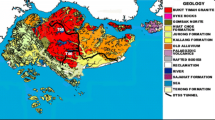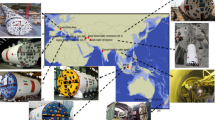Abstract
In the tunnel boring machine (TBM) excavation process, the accurate prediction of the TBM performance, especially the penetration rate, is of great significance to the in time planning, cost control, and safety judgment. In this paper, we propose a prediction method and its corresponding model of penetration rate based on a mechanical analysis. The variables of the method included the design parameters (tunnel radius and cutter arrangement), the operating parameters (the thrust, torque and revolution per minute), and the tensile strength. The rock breakage depth of a single cutter was calculated using the force balance. Then, the rock breakage volume per revolution was obtained by summing up the rock breakage of each cutter based on the cutter arrangement. Finally, based on the premise of knowing the rock breakage volume per revolution, the numerical solution of the penetration rate was acquired. On the basis of the field data from the 4th Section of the Water Supply Project from Songhua River, the accuracy of the model is verified by 59 samples, with a correlation coefficient of 0.64 between prediction and actual results and a mean absolute percentage error of 14.6%. Furthermore, a basic form of the PR prediction equation suitable for different projects was proposed using the single variable control method. For CREC188 TBM in particular, the undetermined coefficient values of the equation were determined using 7-fold cross-validation and the calculation equation was verified with another 50 samples with a correlation coefficient of 0.78 and a mean absolute percentage error of 10.9%.













Similar content being viewed by others

Abbreviations
- α:
-
Strike and dip angle of the fractures and the TBM-driven direction
- ANN:
-
Artificial neural network
- BI:
-
Brittleness index
- BTS:
-
Brazil tensile strength
- CART:
-
Classification and regression trees
- CHAID:
-
Chi-squared automatic interaction detection
- CSM:
-
Colorado School of Mines
- DPW:
-
Distance between plane of weakness
- Fn :
-
The normal force
- Fr :
-
The rolling force (Fr)
- FL:
-
Fuzzy logic
- GEP:
-
Gene expression programming
- GMDH:
-
Group method of data handling
- KNN:
-
K-nearest neighbor
- MAPE:
-
Mean absolute percentage error
- NN:
-
Neural network
- NTNU:
-
Norwegian University of Science and Technology
- PR:
-
Penetration rate
- PSO:
-
Particle swarm optimization
- QTBM :
-
Modified Q system
- R:
-
Radius of the tunnel face
- RIAT:
-
Rolling Indentation Abrasion Test
- RME:
-
Rock mass classification
- RMR:
-
Rock mass rating
- RPM:
-
Revolutions per minute
- RQD:
-
Rock quality designation
- SVM:
-
Support vector machine
- SVR:
-
Support vector regression
- Th:
-
Thrust of the TBM cutterhead
- Tor:
-
Torque of the TBM cutterhead
- WZ:
-
Weathering zone
- {di}:
-
Cutter arrangement
References
Armaghani DJ, Mohamad ET, Narayanasamy MS, Narita N, Yagiz S (2017) Development of hybrid intelligent models for predicting TBM penetration rate in hard rock condition[J]. Tunn Undergr Space Technol 63:29–43
Armaghani DJ, Faradonbeh RS, Momeni E, Fahimifar A, Tahir MM (2018) Performance prediction of tunnel boring machine through developing a gene expression programming equation. Eng Comput 34(1):129–141
Armaghani DJ, Koopialipoor M, Marto A, Yagiz S (2019) Application of several optimization techniques for estimating TBM advance rate in granitic rocks. J Rock Mech Geotech Eng 11:779–789
Avinash P, Singh AP, Loui J, Joy PA, Singh K, Khandelwal M (2012) Validation of RMR-based support design using roof bolts by numerical modeling for underground coal mine of Monnet Ispat, Raigarh, India—a case study. Arab J Geosci 5(6):1435–1448
Barton N (2000) TBM tunnelling in jointed and faulted rock. Balkema
Deng Y, Chen M, Jin Y, Zhang YK, Zou DW, Lu YH (2016) Theoretical and experimental study on the penetration rate for roller cone bits based on the rock dynamic strength and drilling parameters. J Nat Gas Sci Eng 36:117–123
Eraslan AN (2002) Von mises yield criterion and nonlinearly hardening variable thickness rotating annular disks with rigid inclusion. Mech Res Commun 29(5):339–350
Gertsch R, Gertsch L, Rostami J (2007) Disc cutting tests in Colorado red granite: implications for TBM performance prediction. Int J Rock Mech Min Sci 44(2):238–246
Gong QM, Zhao J (2009) Development of a rock mass characteristics model for TBM penetration rate prediction. Int J Rock Mech Min Sci 46(1):8–18
Gong QM, Yin LJ, Ma HS, Zhao J (2016) TBM tunnelling under adverse geological conditions: an overview. Tunn Undergr Space Technol Inc Trenchless Technol Res 57:4–17
Grima MA, Bruines PA, Verhoef PNW (2000) Modeling tunnel boring machine performance by neuro-fuzzy methods. Tunn Undergr Space Technol Inc Trenchless Technol Res 15(3):259–269
Guo RK, Feng C, Li ZJ, Qiao JY, Li SH (2016) Theoretical and experimental studies on relationship between working parameters of cone drill and rock strengths. Chin J Geotechn Eng 38(7):1221–1229
Hamidi JK, Shahriar K, Rezai B, Rostami J (2010) Performance prediction of hard rock TBM using rock mass rating (RMR) system. Tunn Undergr Space Technol 25:333–345
He F, Zeng XS, Qi ZC (2016) Application of large-diameter hard rock tunnel boring machine (TBM) to TBM-3 section of no.4 bid of Songhua River water conveyance project in middle Jilin Province. Tunnel Constrution 36(8):1016–1022
Karimzade E, Sharifzadeh M, Zarei HR, Shahriar K, Cheraghi Seifabadet M (2017) Prediction of water inflow into underground excavations in fractured rocks using a 3D discrete fracture network (DFN) model. Arab J Geosci 10(9):206–219
Koopialipoor M, Nikouei SS, Marto A, Fahimifar A, Armaghani DJ, Mohamad ET (2019a) Predicting tunnel boring machine performance through a new model based on the group method of data handling. Bull Eng Geol Environ 78:3799–2813
Koopialipoor M, Tootoonchi H, Armaghani DJ, Mohamad ET, Hedayat A (2019b) Application of deep neural networks in predicting the penetration rate of tunnel boring machines. Bull Eng Geol Environ. https://doi.org/10.1007/s10064-019-01538-7
Li SC, Liu B, Ren YX, Yang SL, Chen YK, Wang YH, Jiang P (2020) Deep learning inversion of seismic data. IEEE Trans Geosci Remote Sens. https://doi.org/10.1109/TGRS.2019.2953473
Liu B, Pang YH, Mao DQ, Wang J, Liu ZY, Wang N, Liu SH, Zhang XX (2020a) A rapid four-dimensional resistivity data inversion method using temporal segmentation. Geophys J Int. https://doi.org/10.1093/gji/ggaa019
Liu B, Guo Q, Li SC, Liu BC, Ren YX, Pang YH, Guo X, Liu LB, Jiang P (2020b) Deep learning inversion of electrical resistivity data. IEEE Trans Geosci Remote Sens. https://doi.org/10.1109/TGRS.2020.2969040
Mahdevari S, Shahriar K, Yagiz S, Shirazi MA (2014) A support vector regression model for predicting tunnel boring machine penetration rates. Int J Rock Mech Min Sci 72:214–229
Minh VT, Katushin D, Antonov M, Veinthal R (2017) Regression models and fuzzy logic prediction of TBM penetration rate. Open Engineering 7(1):60–68
Nowinki JL (1992) On the three-dimensional Cerruti problem for an elastic nonlocal half-space. ZAMM J Appl Math Mech / Zeitschrift für Angewandte Mathematik und Mechanik 72(7):243–249
Okubo S, Fukui K, Chen W (2003) Expert systems for applicability of tunnel boring machine in Japan. Rock Mech Rock Eng 36:305–322
Oraee K, Salehi B (2013) Assessing prediction models of advance rate in tunnel boring machines—a case study in Iran. Arab J Geosci 6:481–489
Ozdemir L (1977) Development of theoretical equations for predicting tunnel borability. PhD dissertation, Dept. Mining Engineering, Colorado School of Mines
Rostami J, Ozdemir L, Nilsen B (1996) Comparison between CSM and NTH hard rock TBM performance prediction models. In: Proceedings of the annual technical meeting: Institute of Shaft Drilling Technologies (ISDT). Las Vegas, Colorado School of Mines, Golden, CO, USA. p. 11
Salimi A, Rostami J, Moormann C, Delisio A (2016) Application of non-linear regression analysis and artificial intelligence algorithms for performance prediction of hard rock TBMs. Tunn Undergr Space Technol 58:236–246
Torkoy PJ (2009) Simple and practical TBM performance prediction. Einfache und praxistaugliche Voraussage von TBM-Leistungen. Geomechanik Und Tunnelbau 2(2):128–139
Wang LH, Kang YL, Cai ZX, Zhang Q, Zhao Y, Zhao HF, Su PC (2012) The energy method to predict disc cutter wear extent for hard rock. TBMs Tunn Undergr Space Technol Inc Trenchless Technol Res 28(3):183–191
Wang J, Wang RR, Zhang XX, Liu HD, Pang YH (2017) Estimation of TBM performance parameters based on rock mass rating(RMR) system. Tunnel Construction 37(6):700–707
Xu H, Zhou J, Asteris PG, Armaghani DG, Tahir MM (2019) Supervised machine learning techniques to the prediction of tunnel boring machine penetration rate. Appl Sci 9(18):3715
Yagiz S (2017) New equations for predicting the field penetration index of tunnel boring machines in fractured rock mass. Arab J Geosci 10(2):33
Yagiz S, Karahan H (2011) Prediction of hard rock TBM penetration rate using particle swarm optimization. Int J Rock Mech Min Sci 48:427–423
Yagiz S, Gokceoglu C, Sezer E, Iplikic S (2009) Application of two non-linear prediction tools to the estimation of tunnel boring machine performance. Eng Appl Artif Intell 22(4–5):808–814
Yang HQ, Wang H, Zhou XP (2016) Analysis on the damage behavior of mixed ground during TBM cutting process. Tunn Undergr Space Technol 57:55–65
Yang HQ, Li Z, Jie TQ, Zhang ZQ (2018) Effects of joints on the cutting behavior of disc cutter running on the jointed rock mass. Tunn Undergr Space Technol 81:112–120
Acknowledgments
The authors wish to thank the China Railway Tunnel Stock Company Limited for sharing their experiences of data gathering efforts in the field.
We thank LetPub (www.letpub.com) for its linguistic assistance during the preparation of this manuscript.
Funding
This research was supported by the National Natural Science Foundation of China (NSFC) (No. 51739007), The National Key Research and Development Program of China (No. 2016YFC0401805), the National Natural Science Foundation of China (NSFC) (No. U1806226), the Key Research and Development Program of Shandong Province (No Z135050009107), and the Interdisciplinary Development Program of Shandong University (No. 2017JC002).
Author information
Authors and Affiliations
Corresponding author
Additional information
Responsible Editor: Atsushi Sainoki
Rights and permissions
About this article
Cite this article
Wang, R., Guo, X., Li, J. et al. A mechanical method for predicting TBM penetration rates. Arab J Geosci 13, 335 (2020). https://doi.org/10.1007/s12517-020-05305-x
Received:
Accepted:
Published:
DOI: https://doi.org/10.1007/s12517-020-05305-x



